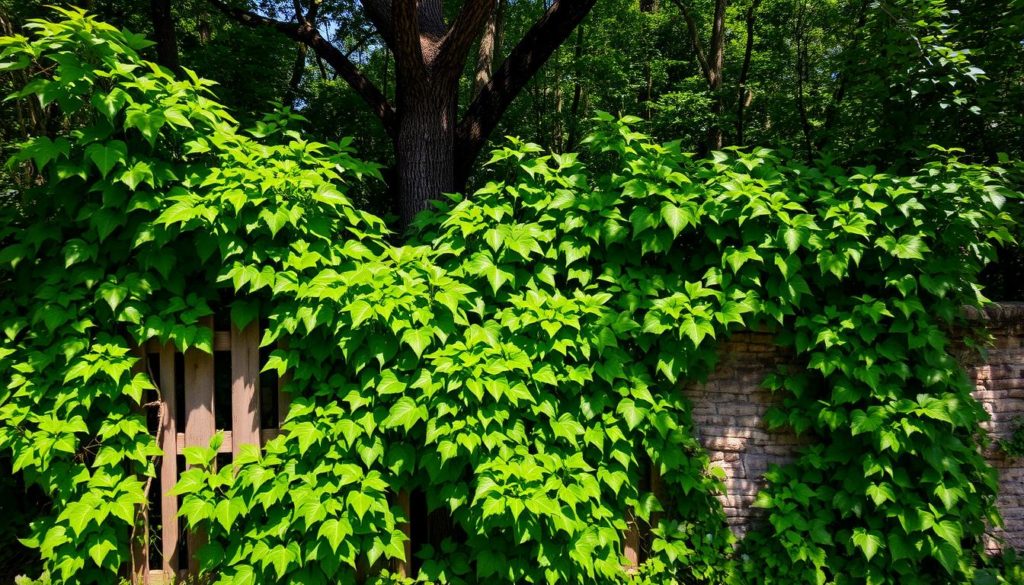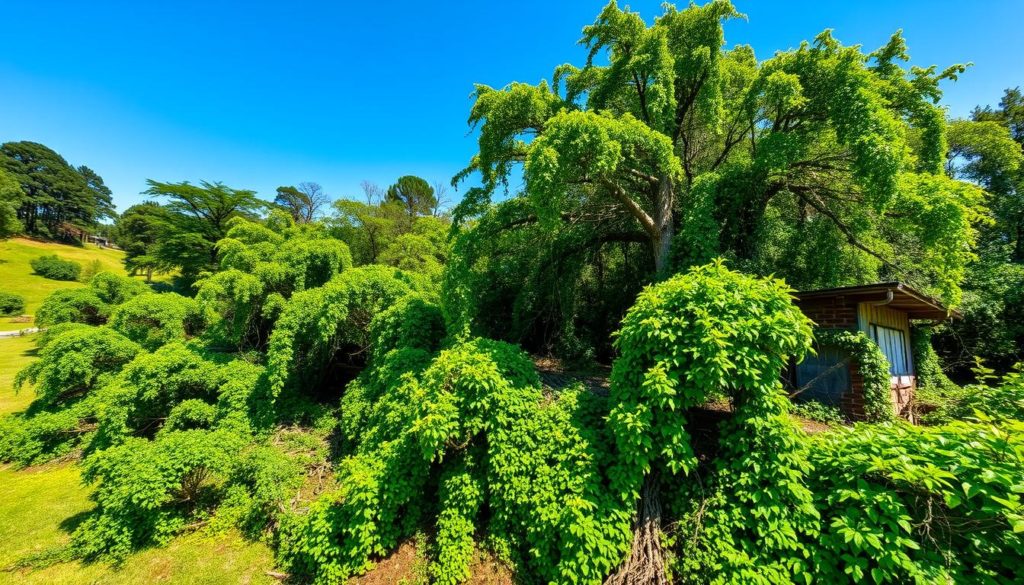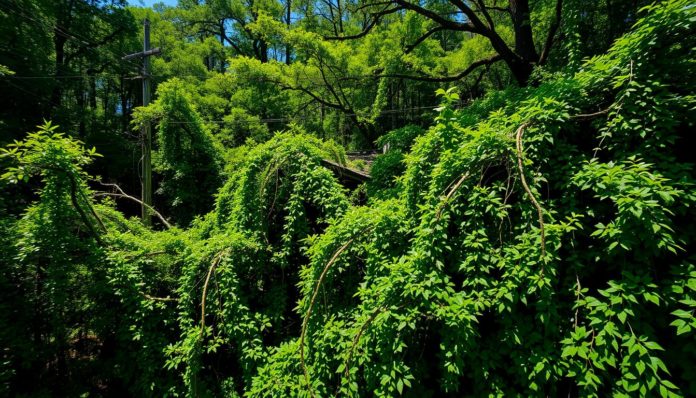Kudzu, an invasive plant, is changing landscapes in the US. It’s a big challenge for ecologists and land managers to find ways to stop it. This plant grows fast and is very hard to kill, making it a big problem for the environment.
We want to show how big the kudzu problem is. We’ll look at different ways to fight it. Knowing how kudzu works is key to stopping it.
We’ll talk about kudzu’s history in the US and how it spreads fast. We’ll see how it affects native plants and the economy. We’ll look at different ways to fight it, like cutting it down or using special plants to kill it.
As we keep fighting kudzu, we might find new ways to control it. These could help us use this aggressive vine for good.
Understanding the Kudzu Crisis
Kudzu, known as the “vine that ate the South”, is a big problem in many US states. This section will explain why kudzu is a threat. It started as a pretty plant but now harms the environment.
Origins: How Kudzu Became a US Problem
Kudzu was first brought to the US in 1876, at the Philadelphia Centennial Exposition. It was seen as a pretty bush and a food source. But in the 1930s and ’40s, it was spread by the Soil Conservation Service to stop soil erosion in the southeast.
Without natural enemies in the US, kudzu grew fast. This led to the kudzu problem we see today.
Spread Pattern: Analyzing the Growth Rate of This Vine Species
Kudzu grows incredibly fast, up to a foot a day in peak seasons. It can grow 60 feet a year. This fast growth lets it take over, killing other plants by blocking their sunlight and water.
The vine spreads through seeds and roots. This makes it hard to stop its growth. The damage it causes is huge, affecting nature and landscapes.

Understanding why kudzu spreads so much helps us find ways to stop it. We can work on solutions to lessen its harm.
Kudzu
Kudzu is known as the “vine that ate the South.” It’s a fast-growing vine from Asia. In the US, it’s seen as a bad invasive plant because it grows so fast and takes over native plants.

This vine loves many types of soil, mainly in the southeast US. Its fast growth makes kudzu hard to control. It can grow a foot a day, covering trees, shrubs, and buildings quickly.
- Extensive root system that can penetrate deep into the soil
- Large leaves that effectively shade out competing plants by blocking sunlight
- Ability to fix nitrogen, which can improve soil fertility but also disrupts local nitrogen cycles and plant communities
Kudzu’s ability to grow in many places and its aggressive growth show why we need good ways to manage it. This helps protect local ecosystems from its harm.
Environmental Impacts of Kudzu Proliferation
Kudzu, an invasive plant, is spreading across the United States. It harms local environments and threatens native plants and animals. This section explores how kudzu’s growth affects biodiversity and changes ecological balances.
Effects on Native Flora and Fauna
Kudzu grows very fast, taking over space, light, and nutrients from other plants. This competition greatly reduces native species. It disrupts the food chain and habitats of animals that rely on these plants.
The loss of biodiversity is severe. It’s essential for keeping ecosystems healthy.
Threats to Biodiversity and Ecosystems
Your work ends here.
Economic Consequences of Kudzu Domination
Kudzu has spread across many areas, causing big economic consequences. It mainly hurts agriculture and forestry. This fast-growing vine competes with crops, kills trees, and damages buildings and roads.
Damage to Agriculture and Forestry
Kudzu’s effect on agriculture is huge. It covers a lot of land, making it hard to grow crops. Forestry also suffers as kudzu blocks access to trees and stops young trees from growing.
Financial Burden of Kudzu Management
Controlling kudzu costs a lot of money. Many management techniques are used to stop it, but they are expensive. Here’s a table showing the costs of different methods.
| Management Technique | Cost (per acre) | Effectiveness |
|---|---|---|
| Mechanical Removal | $500 | High |
| Chemical Treatment | $300 | Medium to High |
| Biological Control | $200 | Variable |
| Preventive Measures | $150 | Low to Medium |
This table shows how much money is spent to fight kudzu. It shows we need better and cheaper ways to manage it.
Methods of Kudzu Control and Management
Kudzu, an invasive plant, is a big problem in many places. To tackle it, we need strong kudzu management techniques. There are several control methods to fight this aggressive vine. Let’s look at the main ways to get rid of kudzu.
- Mechanical Removal
- Chemical Treatment
- Biological Control
Mowing and pulling out kudzu works well for small areas. For bigger spots, herbicides are a good choice. But, we must use them carefully to avoid harming other plants and animals. Biological control uses natural enemies or diseases to fight kudzu, which could be a lasting fix.
| Method | Advantages | Drawbacks |
|---|---|---|
| Mechanical Removal | Immediate results, eco-friendly | Labor-intensive, not feasible for large infestations |
| Chemical Treatment | Effective over large areas, fast-acting | Potential harm to other plants, requires careful application |
| Biological Control | Environmentally sustainable, reduces chemical use | Slow results, limited by biological factors |
It’s key to mix these control methods for a custom kudzu management plan. This plan should fit the local area and ecosystem. A detailed approach helps us fight this invasive plant better.
Chemical Warfare: Herbicides in the Fight Against Kudzu
In the battle against kudzu, chemical control with herbicides is a key strategy. It’s important to know the difference between selective herbicides and non-selective herbicides. This knowledge helps in fighting this aggressive vine effectively.
Pros and Cons of Chemical Control Methods
Chemical methods quickly reduce kudzu patches. But, they can harm the environment, including other plants and soil health. This is a big concern.
Selective versus Non-selective Herbicides for Kudzu
Choosing between selective and non-selective herbicides is key. Selective herbicides target specific plants, like kudzu. Non-selective herbicides, on the other hand, can harm all plants they touch.
| Type of Herbicide | Efficacy | Environmental Impact | Application Tips |
|---|---|---|---|
| Selective Herbicides | Highly effective on kudzu | Lower risk to non-target plants | Apply during active growth phases |
| Non-Selective Herbicides | Effective on kudzu and other weeds | High risk to all vegetation | Use cautiously to avoid drift |
Mechanical and Manual Kudzu Removal Techniques
Dealing with kudzu requires a variety of methods. Mechanical and manual techniques are key in fighting this aggressive plant. These methods help control kudzu and reduce harm to the environment.
The Role of Mowing and Grazing in Kudzu Management
Mowing is a main strategy for removing kudzu. It cuts the vines back to the ground regularly. This stops the vine from growing and spreading seeds.
Regular mowing weakens the roots, making the infestation easier to handle.
Grazing, using animals like goats, is also important. These animals eat kudzu, making it easier to clear areas. Grazing not only removes the vines but also helps the soil and native plants.
To show how mowing and grazing work well for kudzu control, see the table below:
| Method | Pros | Cons | Frequency Needed |
|---|---|---|---|
| Mowing | Controls spread by preventing seeding | Labour-intensive, requires equipment | Every 3-4 weeks during growing season |
| Grazing | Cost-effective, benefits ecosystem health | Requires fencing and herd management | Continuously as needed |
Choosing between mowing and grazing depends on the situation and resources. Both are key to controlling kudzu in a sustainable way.
Biological Control Solutions: Utilizing Nature’s Defenses
Researchers and ecologists are fighting kudzu with new biological control methods. These use natural defenses. They are better for the environment than chemicals and aim for long-term success in kudzu management methods.
One key approach is to bring in natural predators of kudzu. These can be insects or microbes. This way, kudzu can be controlled without harming other plants and animals.
- Introduction of predators like the kudzu bug, which feeds only on kudzu vines.
- Use of fungal pathogens that attack kudzu roots and slow its growth.
- Employment of competitive plant species that outcompete kudzu for nutrients and sunlight.
These biological control methods are part of the solution to the kudzu problem. It’s important to research and watch them closely to avoid bad effects on nature. Science and nature working together is key here.
Unexplored Benefits and Uses of Kudzu
Kudzu is known as an invasive species, but it has hidden benefits. Research shows kudzu is more than just a problem. It has untapped uses that are worth exploring.
Kudzu fibers can be used to make biodegradable products. This could help reduce plastic use. It’s also a cheap, green option for industries looking to be more eco-friendly.
In medicine and nutrition, kudzu is showing promise. It may help control blood sugar and reduce drug use. The plant’s root, leaves, and flowers are also edible, rich in nutrients.
FAQ
What is Kudzu and why is it considered an invasive plant in the US?
Kudzu is a fast-growing vine from Asia. It’s invasive because it covers landscapes, beats out native plants, and messes with local ecosystems.
How did Kudzu become a problem in the United States?
Kudzu was brought to the US for looks and to stop soil erosion. But, it grew too fast and took over natural areas, becoming a big problem for the environment and farms.
What are the environmental impacts of Kudzu proliferation?
Kudzu’s spread hurts biodiversity. It kills native plants, changes habitats, and affects wildlife and forests.
What are the economic consequences of Kudzu domination?
Kudzu hurts the economy by damaging crops, competing with farms, and harming forests. It also costs a lot to manage and control.
What methods are used to control and manage Kudzu?
To fight Kudzu, people use mowing, grazing, herbicides, and natural enemies. Mixing these methods works best.
Can Kudzu be beneficial in any way?
Yes, Kudzu has good uses. It’s used in making materials, traditional medicines, and as food in some cultures.
What is the average growth rate of Kudzu?
Kudzu grows fast, up to a foot a day in good weather. This lets it quickly take over areas.
Why is a multifaceted approach important in managing Kudzu?
Fighting Kudzu needs many strategies because it’s tough and adaptable. Different methods work in different places to keep it under control.
Are there chemical-free ways to control Kudzu?
Yes, you can use tools like cutting and grazing animals. You can also use natural enemies to fight Kudzu without chemicals.
What should be considered when using herbicides to fight Kudzu?
When using herbicides, think about the type, when to use it, and how it might affect the environment. Also, consider how it might harm other plants and animals.


